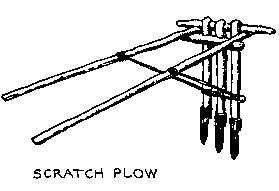As did people in other parts of Europe, the vast majority of the Rus'
probably spent their lives growing food. By the 13th century, hoes had
given way to multi-pronged scratch plows, so that horse power could be used
in the rough-cleared forests of the north. The climate made farming
difficult. Archaeological evidence shows the gradual adaptation of
additional crops and eventual adoption of two-and-three field crop rotation
systems. Agricultural tools of the time included sickles, scythes, metal
sheathed wooden shovels, rakes, and gardening tools.(1) There is good
evidence the Rus' raised vegetables, as well as grains. Flax and hemp were
grown for linen, rope, oil, and perhaps recreation.(2) Animals, including
cattle, sheep, oxen, pigs, goats, doves, chickens, ducks and swans, were
raised for food.
Forest products were a mainstay of Russian economic life. All parts of a
tree were used-timber, bark, and wood fibers. Mushrooms were gathered to
supplement the diet. Hunting provided meat for the table, from elk and
European bison to rabbits and hazel hens. Besides food, hunting provided
furs and leather for clothing and commerce. Specialized weapons and tools,
such as boar spears and skinning knives, were made for this work. Animals
were taken by spears, bow and arrows, nets, and snares. Hunting nets were
legally protected from damage.(3) Special hunting reserves for the nobility
are recorded in period law.(4)
Fishing had an important place in the Rus' economy. Nets, net weights,
barbed fishhooks, spoon baits, fish spears, specialized arrows, and
tridents were all used by Rus' fishermen.(5)
Beekeeping was also extremely important. Many laws prescribe rules for the
identification of hollow log hives and protection of preserves for
apiculture. This is hardly surprising, given the importance of honey and
wax for export.(6) In the Ordinance of Yaroslav, an early Russian legal
code, there are 121 articles, of which 6 protect beekeeping.(7) From
Russian
Law:
"If anyone damages or burns a prince's hive, three grivna"(8)
"If anyone obliterates the sign on a beehive, twelve grivna"(9)
